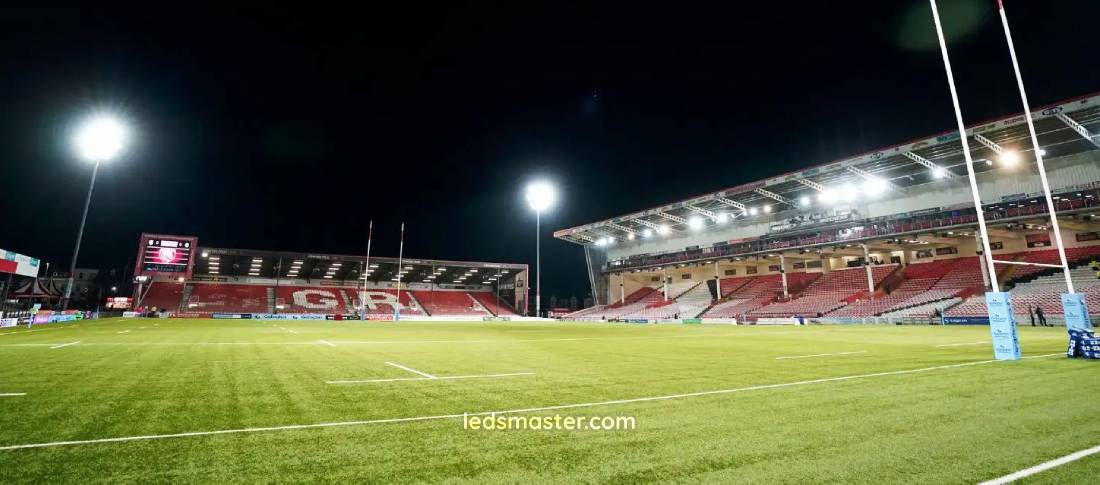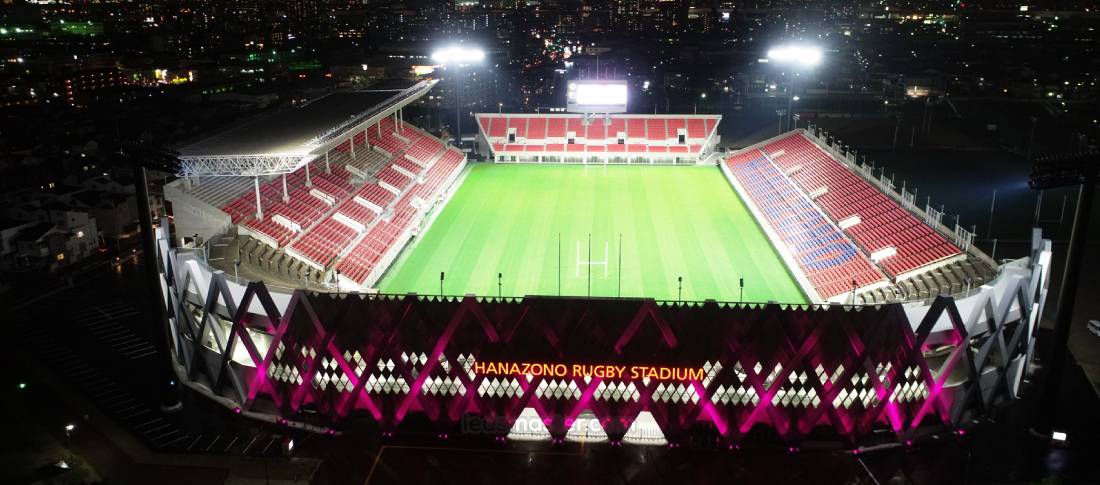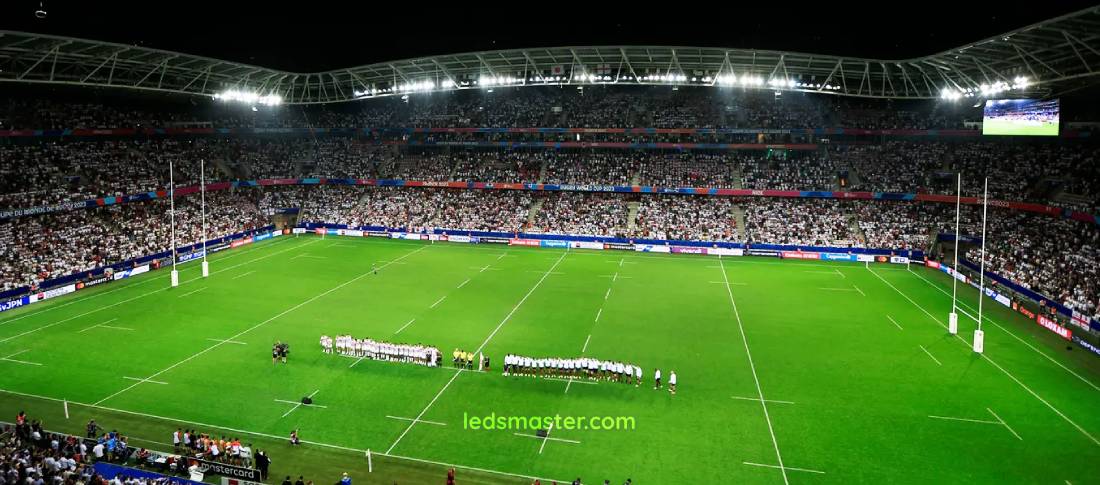Picture a rugby game brilliantly lit for perfect visibility and safety. Discover how to choose the right lighting technology and manage costs to keep your field shining bright and within budget.
Get your complimentary lighting design today
Proper illumination enhances visibility, maintains game quality, and supports player safety. Understanding the various factors that influence the cost of rugby field lighting helps in making informed decisions about the most suitable and budget-friendly lighting solutions.
Table of Contents
Toggle
The initial costs for rugby field lighting primarily consist of the price of equipment—such as light fixtures, poles, and control systems—and the cost of installation. For instance, lighting fixtures typically range from $2,000 to $10,000 per pole, depending on the quality and technology used. Poles themselves may cost between $1,500 and $5,000 each, depending on height and material. Installation costs can add another $10,000 to $25,000 to the project, covering labor, trenching for electrical cables, and securing permits.
The type of lighting technology plays a significant role in the overall expense. LED lights, for example, have a higher upfront cost, typically ranging from $500 to $1,200 per fixture. In comparison, metal halide lights are less expensive, averaging between $250 and $500 per fixture. While LED lighting may cost more initially, its better performance, energy efficiency, and longer lifespan make it a preferred choice for long-term value. The complexity of the lighting design, including factors like dimming systems and smart controls, can further impact both equipment and installation costs.
Operational costs refer to the ongoing expenses required to keep the rugby field lighting system running efficiently. The primary operational expense is electricity consumption, which varies based on the type of lighting technology employed. LED lights, for example, consume 30-60% less energy compared to metal halide lights, leading to lower electricity bills. Depending on local electricity rates and usage hours, running LED lights can cost $0.10 to $0.25 per hour per fixture, compared to $0.30 to $0.75 per hour for metal halide systems.
Additionally, regular maintenance and repairs contribute to operational costs. LED lights typically have a lifespan of 50,000 to 100,000 hours, reducing the frequency of replacement and maintenance needs. Metal halide lights, on the other hand, have shorter lifespans, around 6,000 to 15,000 hours, and may require lamp replacements every 2-3 years, along with more frequent inspections, which can lead to higher long-term maintenance costs. Professional maintenance services for lighting systems can range from $200 to $1,000 per year depending on the size of the installation.
Long-term costs consider the total expenses of operating the lighting system over its full lifecycle, including initial, operational, and maintenance costs. The durability and lifespan of the chosen lighting system are crucial factors in determining long-term costs. LED lights, with their extended lifespan of up to 10-15 years and minimal maintenance needs, offer significant savings over time. Although the initial investment for LEDs may be higher, their energy savings and reduced maintenance result in lower long-term expenses. For instance, the cumulative cost of running and maintaining LED lights over 10 years might be 40-70% less than a metal halide system.
In contrast, metal halide lights typically have higher long-term costs due to their shorter lifespan and more frequent need for replacement. Over a 10-year period, replacing fixtures and ballasts for metal halide systems can add 20-40% to the overall expenses. Additionally, their higher energy consumption leads to increased operational costs, which further widens the cost gap between metal halide and LED systems.
| Cost Category | LED Lights | Metal Halide Lights |
|---|---|---|
| Initial Costs | Fixture Price: $500 – $1,200 per fixture | Fixture Price: $250 – $500 per fixture |
| Pole Cost: $1,500 – $5,000 per pole | Pole Cost: $1,500 – $5,000 per pole | |
| Installation Cost: $10,000 – $25,000 | Installation Cost: $10,000 – $25,000 | |
| Total Initial Cost: Higher upfront cost | Total Initial Cost: Lower upfront cost | |
| Operational Costs | Electricity Consumption: $0.10 – $0.25/hour per fixture | Electricity Consumption: $0.30 – $0.75/hour per fixture |
| Maintenance Frequency: Low (50,000 – 100,000 hours lifespan) | Maintenance Frequency: Higher (6,000 – 15,000 hours lifespan) | |
| Annual Maintenance Cost: $200 – $500 | Annual Maintenance Cost: $500 – $1,000 | |
| Long-Term Costs | Lifespan: 10-15 years | Lifespan: 2-3 years (frequent replacements) |
| Energy Savings: 30-60% less energy usage | Energy Consumption: Higher energy usage | |
| Total Long-Term Cost: 40-70% less over 10 years | Total Long-Term Cost: Higher due to frequent replacements and higher energy consumption |

The size of the rugby field is a primary determinant in the overall cost of lighting. Larger fields require more lighting fixtures and poles to achieve adequate illumination. The layout and design of the lighting system must ensure that the entire field is evenly lit, which can involve significant expenses, particularly for high-quality systems. The scale of the field directly impacts both the number of lights needed and the complexity of the installation.
The choice of lighting technology affects both the initial and ongoing costs. LED lights, while more expensive upfront, offer substantial savings over time due to their energy efficiency and reduced maintenance requirements. In contrast, metal halide lights, though initially cheaper, result in higher long-term costs due to their higher energy consumption and more frequent replacements.
The complexity of the installation process can significantly influence the total cost of the lighting system. Factors such as the need for specialized equipment, the height of the poles, and the complexity of the wiring all contribute to the overall expense. Professional installation is often required to ensure that the lighting system is set up correctly and meets all safety standards.
Ongoing maintenance is a key factor in the total cost of lighting. Regular upkeep, including bulb replacements and system repairs, is necessary to keep the lights functioning properly. LED lights typically require less maintenance compared to traditional options, which can help reduce long-term costs. However, it is still important to budget for periodic maintenance to ensure the system remains in good working condition.
The energy consumption of the lighting system has a direct impact on operational costs. LED lights are known for their low energy usage, which translates into lower electricity bills. Traditional lighting options, such as metal halide lights, consume more power and thus result in higher energy costs. When evaluating lighting options, it is crucial to consider not only the initial cost but also the long-term energy expenses.

Floodlights are commonly used for rugby fields due to their ability to provide broad and intense illumination. These lights are mounted on tall poles around the field to ensure even distribution of light. While effective, the cost of floodlights can vary significantly based on the type of bulbs used, their wattage, and the number of units required. Traditional floodlights, often equipped with metal halide bulbs, are known for their high-intensity output, but they come with higher energy consumption and maintenance costs.
LED lighting has become increasingly popular for sports fields, including rugby fields, due to its energy efficiency and long lifespan. Although the initial investment in LED technology can be higher than traditional options, the long-term savings on energy and maintenance often offset these costs. LEDs are known for their ability to provide high-quality, consistent lighting while consuming less power, which makes them a more sustainable option.
Metal halide lights have been a traditional choice for sports fields for many years. They offer a bright and clear light that is suitable for large areas. However, metal halide lights are less energy-efficient compared to LEDs and typically have shorter lifespans. This results in higher operational costs due to frequent bulb replacements and increased energy consumption.
Solar lighting is an environmentally friendly option that utilizes solar panels to power the lights. While the initial setup cost for solar lighting can be substantial, it offers the advantage of minimal ongoing energy costs. Solar lights are particularly appealing for locations with abundant sunlight. However, their effectiveness can vary based on geographical location and weather conditions, which can influence their overall cost and performance.
For smaller community rugby fields, cost-effective lighting solutions are a key consideration. These fields often choose more affordable options like metal halide lights or basic LED systems. For example, a community rugby field installation might cost between $25,000 and $40,000 using metal halide lights. However, the initial savings from these traditional systems can be offset by the higher operational and maintenance costs. Metal halide systems have a shorter lifespan (6,000 to 15,000 hours) and higher energy consumption, resulting in up to $5,000 per year in electricity and maintenance expenses.
In contrast, opting for a basic LED system may increase the upfront investment to $40,000 – $60,000, but the energy savings (30-60% less than metal halide) and reduced maintenance can lower annual operational costs to around $2,000 to $3,000. Over a 10-year period, a community field might save $15,000 to $25,000 by using LEDs despite the higher initial expense.
| Field Type | Lighting Type | Initial Cost | Annual Operational Cost | 10-Year Cost (Est.) |
|---|---|---|---|---|
| Small Community Field | Metal Halide | $25,000 – $40,000 | $4,000 – $5,000 | $65,000 – $90,000 |
| Small Community Field | Basic LED | $40,000 – $60,000 | $2,000 – $3,000 | $60,000 – $75,000 |
In contrast, professional rugby stadiums require premium lighting solutions to ensure optimal visibility, performance, and safety. These stadiums typically install high-end LED lighting systems, which can cost between $500,000 to $1 million. For instance, a top-tier stadium might install a 200,000-lumen LED system with advanced controls for dimming, color tuning, and minimal glare for TV broadcasts.
Although the upfront cost for a professional LED system is significant, the energy savings are substantial. LED systems consume 50-60% less energy than traditional metal halide lights, reducing annual energy costs by $10,000 to $50,000, depending on usage hours. Additionally, LED systems last up to 15 years, while metal halide systems may require full replacements every 2-3 years.
| Stadium Type | Lighting Type | Initial Cost | Annual Operational Cost | 10-Year Cost (Est.) |
|---|---|---|---|---|
| Professional Rugby Stadium | Metal Halide | $200,000 – $400,000 | $30,000 – $50,000 | $500,000 – $800,000 |
| Professional Rugby Stadium | Advanced LED | $500,000 – $1 million | $10,000 – $30,000 | $600,000 – $1.2 million |
A comparative analysis between metal halide and LED lighting systems reveals the financial trade-offs between the two options. While metal halide lights offer lower upfront costs, they typically have higher long-term operational and maintenance costs. Conversely, LED systems—despite higher initial investment—provide better energy efficiency, lower maintenance costs, and a longer lifespan.
For example, a 10-pole lighting system using metal halide lights may cost around $300,000 initially, but over 10 years, the total cost, including energy and maintenance, could exceed $800,000. In comparison, an LED system for the same installation might cost $500,000 initially, but the 10-year total cost could be $600,000, representing significant savings over time.
| Lighting Type | Initial Cost | Annual Operational Cost | Maintenance Cost | 10-Year Total Cost |
|---|---|---|---|---|
| Metal Halide System | $250,000 – $400,000 | $30,000 – $50,000 | $10,000 – $20,000 | $600,000 – $900,000 |
| LED System | $500,000 – $1 million | $10,000 – $30,000 | $2,000 – $10,000 | $600,000 – $1.2 million |
Accurate cost estimation is crucial for budgeting and financial planning. Various online tools and calculators are available to help estimate the costs associated with different lighting options. These tools take into account factors such as field size, lighting technology, and installation complexity to provide a comprehensive cost estimate. Utilizing these resources can aid in making informed decisions and managing the financial aspects of the lighting project.
Exploring financing options can help manage the costs of rugby field lighting. Grants, sponsorships, and other financial aids may be available to support the installation of lighting systems. It is worth researching potential funding sources and understanding the eligibility criteria for various financial assistance programs. By securing additional funding, it is possible to offset some of the initial costs and make the project more affordable.
Conducting a cost-benefit analysis helps in evaluating the long-term financial impact of different lighting solutions. This analysis involves comparing the initial investment with the expected savings in energy and maintenance costs. By assessing the overall value of each lighting option, it is possible to make a decision that aligns with both budget constraints and performance needs.
The cost of rugby field lighting is influenced by a variety of factors, including the type of lighting technology, field size, and installation complexity. By understanding these factors and exploring different options, it is possible to make informed decisions that balance initial expenses with long-term benefits. Proper budgeting and financial planning play a key role in managing the costs and ensuring that the lighting system meets both performance and financial requirements.
Choosing the right lighting for a rugby field involves balancing visibility, safety, and cost. By evaluating various lighting technologies and understanding their associated costs, you can make an informed decision that enhances game quality and meets budget constraints. With careful planning and consideration of long-term benefits, you can ensure that your rugby field remains well-lit, functional, and enjoyable for players and spectators alike.